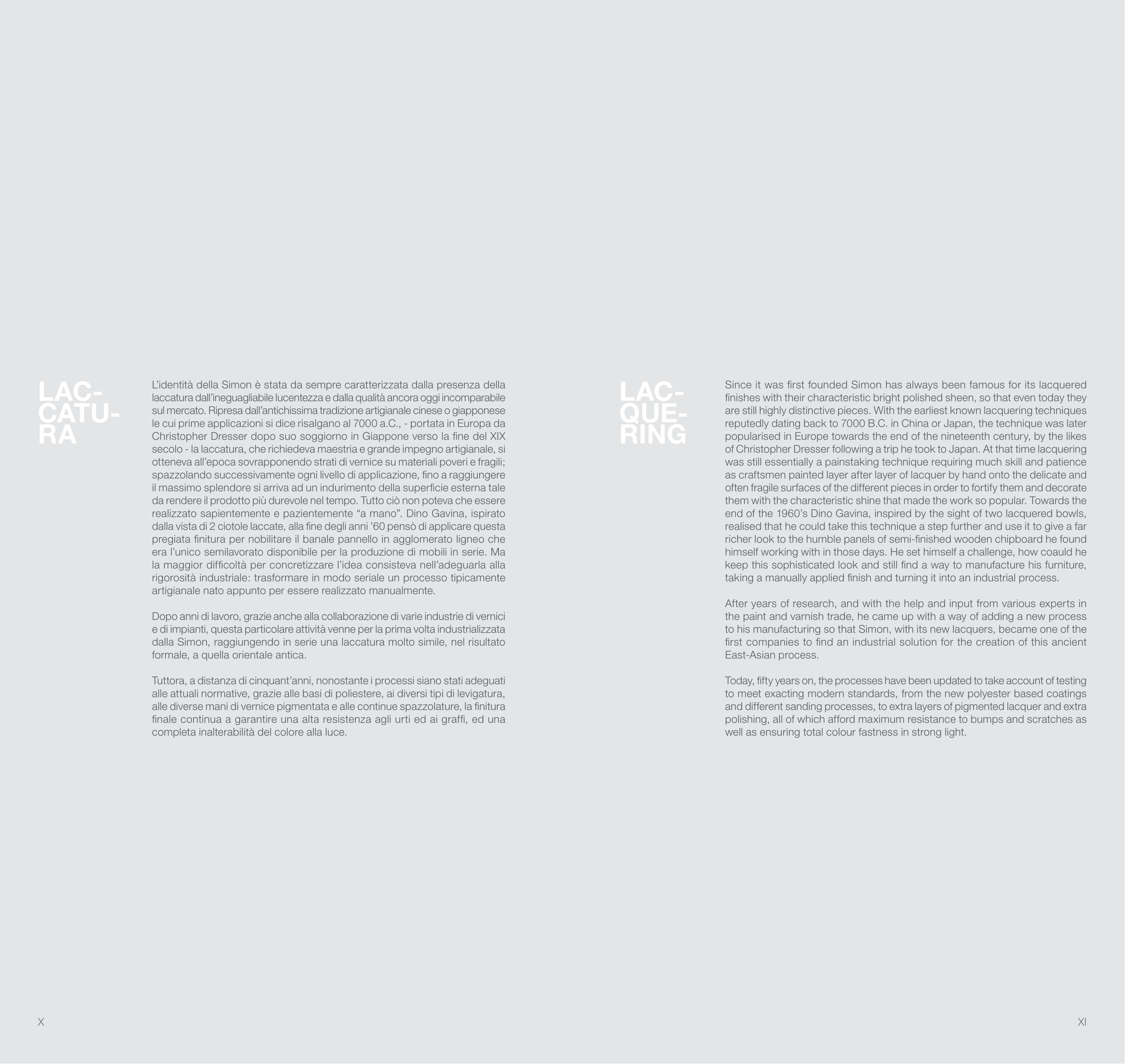L’identità della Simon è stata da sempre caratterizzata dalla presenza della
laccatura dall’ineguagliabile lucentezza e dalla qualità ancora oggi incomparabile
sul mercato. Ripresa dall’antichissima tradizione artigianale cinese o giapponese
le cui prime applicazioni si dice risalgano al 7000 a.C., - portata in Europa da
Christopher Dresser dopo suo soggiorno in Giappone verso la fine del XIX
secolo - la laccatura, che richiedeva maestria e grande impegno artigianale, si
otteneva all’epoca sovrapponendo strati di vernice su materiali poveri e fragili;
spazzolando successivamente ogni livello di applicazione, fino a raggiungere
il massimo splendore si arriva ad un indurimento della superficie esterna tale
da rendere il prodotto più durevole nel tempo. Tutto ciò non poteva che essere
realizzato sapientemente e pazientemente “a mano”. Dino Gavina, ispirato
dalla vista di 2 ciotole laccate, alla fine degli anni ’60 pensò di applicare questa
pregiata finitura per nobilitare il banale pannello in agglomerato ligneo che
era l’unico semilavorato disponibile per la produzione di mobili in serie. Ma
la maggior difficoltà per concretizzare l’idea consisteva nell’adeguarla alla
rigorosità industriale: trasformare in modo seriale un processo tipicamente
artigianale nato appunto per essere realizzato manualmente.
Dopo anni di lavoro, grazie anche alla collaborazione di varie industrie di vernici
e di impianti, questa particolare attività venne per la prima volta industrializzata
dalla Simon, raggiungendo in serie una laccatura molto simile, nel risultato
formale, a quella orientale antica.
Tuttora, a distanza di cinquant’anni, nonostante i processi siano stati adeguati
alle attuali normative, grazie alle basi di poliestere, ai diversi tipi di levigatura,
alle diverse mani di vernice pigmentata e alle continue spazzolature, la finitura
finale continua a garantire una alta resistenza agli urti ed ai graffi, ed una
completa inalterabilità del colore alla luce.
Since it was first founded Simon has always been famous for its lacquered
finishes with their characteristic bright polished sheen, so that even today they
are still highly distinctive pieces. With the earliest known lacquering techniques
reputedly dating back to 7000 B.C. in China or Japan, the technique was later
popularised in Europe towards the end of the nineteenth century, by the likes
of Christopher Dresser following a trip he took to Japan. At that time lacquering
was still essentially a painstaking technique requiring much skill and patience
as craftsmen painted layer after layer of lacquer by hand onto the delicate and
often fragile surfaces of the different pieces in order to fortify them and decorate
them with the characteristic shine that made the work so popular. Towards the
end of the 1960’s Dino Gavina, inspired by the sight of two lacquered bowls,
realised that he could take this technique a step further and use it to give a far
richer look to the humble panels of semi-finished wooden chipboard he found
himself working with in those days. He set himself a challenge, how coauld he
keep this sophisticated look and still find a way to manufacture his furniture,
taking a manually applied finish and turning it into an industrial process.
After years of research, and with the help and input from various experts in
the paint and varnish trade, he came up with a way of adding a new process
to his manufacturing so that Simon, with its new lacquers, became one of the
first companies to find an industrial solution for the creation of this ancient
East-Asian process.
Today, fifty years on, the processes have been updated to take account of testing
to meet exacting modern standards, from the new polyester based coatings
and different sanding processes, to extra layers of pigmented lacquer and extra
polishing, all of which afford maximum resistance to bumps and scratches as
well as ensuring total colour fastness in strong light.
LAC-
CATU-
RA
LAC-
QUE-
RING
X
XI


